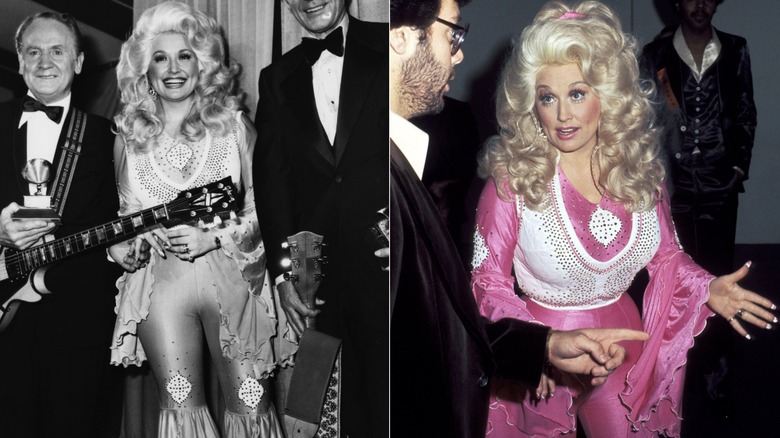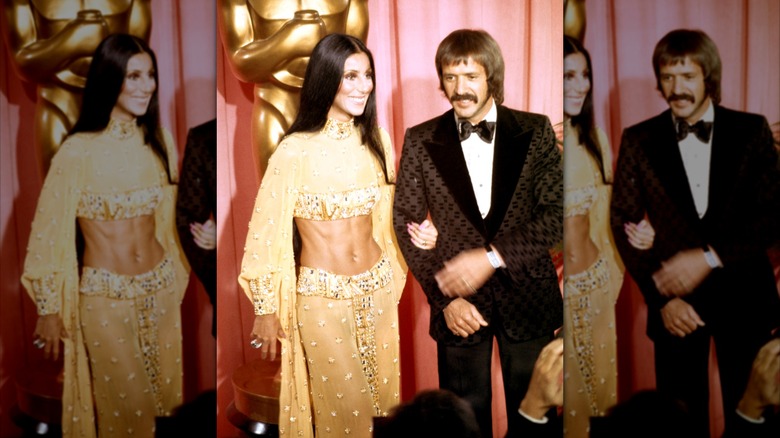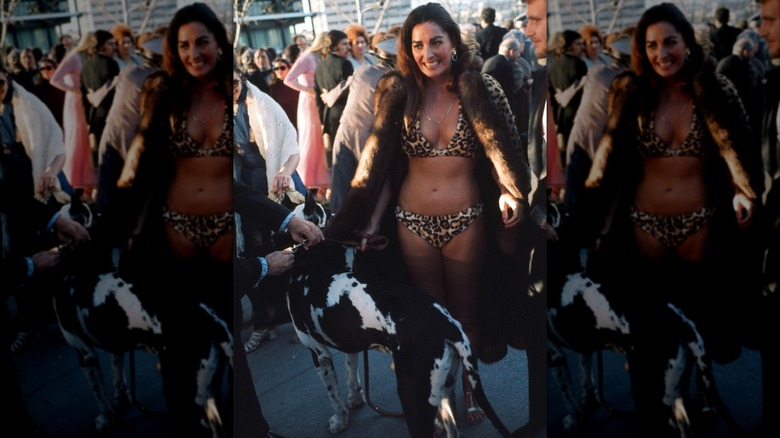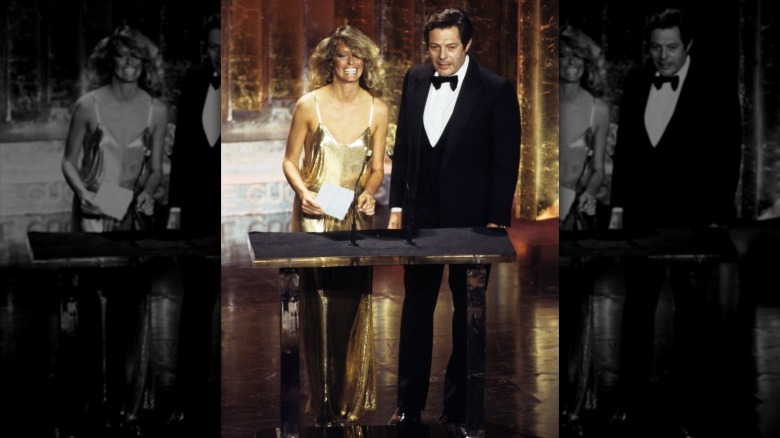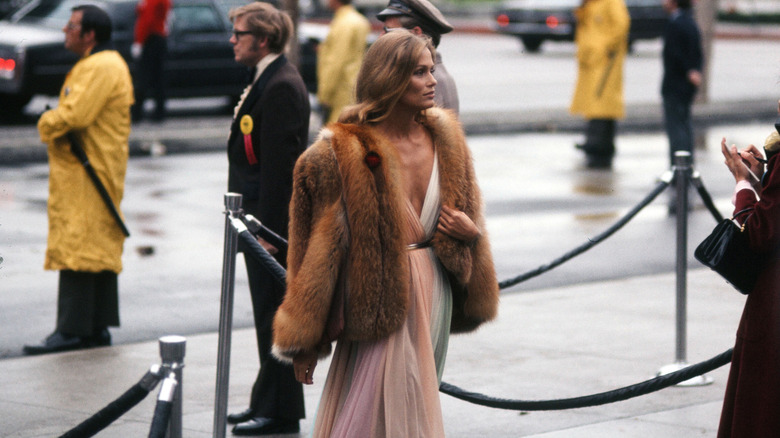The Most Iconic Red Carpet Looks Of The 1970s
From disco and punk to "Star Wars," ABBA, and shag carpets, the 1970s were an incredibly visual decade. Intergalactic patterns mingled with warm colors, florals, and a psychedelic feel. But don't take it from us, all you need to do to confirm just how visually groovy the 1970s were is turn towards the red carpets of yesteryear.
Stars throughout the decade were turning out their best looks night after night at award shows. From music icons like Cher and Aretha Franklin pushing the boundaries of what was acceptable for women on the global stage to hitmakers like Isaac Hayes breaking barriers for African-American artists — and doing it in style — the 1970s were a treasure trove of far-out fashion. While bell-bottoms were best left to street style, music and movies' biggest nights regularly saw A-listers walking the carpet in skin-bearing frocks, fascinating fur-lined pieces, mega-sized jewels, and, often, a mixture of all three.
To narrow down the best red carpet looks of the 1970s, we cast a wide net, looking into the award show archives for evidence of transgressive dressing, meaning looks that pushed fashion forward, or iconic outfits that still creep into headlines today. While this decade began over 50 years ago, it seems that the aesthetic of the '70s is not something we're keen to bid adieu to any time soon. So let's go back to a time when Richard Nixon was in the White House and platform shoes were all the rage.
Dolly Parton's bubblegum pink look at the 1977 Grammys
The stunning transformation of Dolly Parton begins with the story of a small-town girl who sang her way out of Tennessee and straight into the history books. The country music icon was also known for turning up bedazzled and bodacious at award shows, during TV appearances, and more. Many of Parton's most memorable outfits are remembered fondly today. However, one gorgeous ensemble seemed miles ahead of the fashion curve: a bubblegum-hued cowboy suit. Parton wore the form-fitting ensemble to the 1977 Grammy Awards in Hollywood.
Decades before Barbiecore fashion took the world by storm, launched to the forefront of pop culture thanks to the 2023 film starring Margot Robbie, Parton was already looking like a walking, talking, singing Barbie doll. The one-piece bright pink suit is well-remembered for being a stark contrast to the slinky gowns regularly seen on the 1970s red carpet.
Instead, Parton strutted her stuff with a cowboy's charisma, all while still standing firm in her femininity. With flowing sleeves, period-perfect bell-bottoms, and white, rhinestone stars and sparkle patterns dotted along her bodice and knees, this out-of-the-box ensemble perfectly encapsulated what the "Jolene" singer was all about.
Aretha Franklin goes glittery in 1970
Nothing demands R-E-S-P-E-C-T quite like a gown covered head-to-toe in glitter. Singer extraordinaire Aretha Franklin, often nicknamed the "Queen of Soul," asserted her fashion dominance when attending the 1970 Grammy Awards wearing a crimson-colored dress. It was even fit with swirling gold patterns in glitter and a matching headscarf.
Her balloon sleeves and heavily embroidered bodice were dotted with so many gold details that the glitter ricocheted off the flashing bulb of the paparazzi's cameras, winking back at the viewer. Gold circular details lined the opening of her ultra-trendy headscarf. In the 1970s, headscarves were advancing up the fashion ladder. Inspired by the bohemian subculture, women regularly wore scarves in both forehead-hugging styles and looser models, which Franklin opted for here. Nevertheless, Franklin was more of trendsetter than a trend-follower. "She was a fashion icon but not in the traditional sense. ... As she moved through the narrative of her life, it seems evident her clothing simply followed her life," costumer designer Clint Ramos told the Los Angeles Times. "She wasn't a fashion plate or a mannequin or anything like that — she was telegraphing the way she felt through clothing the same way she did with her music."
On the night of the Grammys, Franklin's blue eyeshadow and golden Grammy Award were the cherries on top of this red velvet cake, tying up the pianist and singer's look with an especially colorful, regal bow. Rolling Stone might have given Franklin the title of "greatest singer of all time" in 2023, but this kind of adventurous dressing also makes her a worthy contender for "best dresser of all time" as well.
Sacheen Littlefeather at the Oscars in 1973
When Sacheen Littlefeather's look at the 1973 Oscars ceremony made history, it wasn't just for the designer label or radical silhouette. Instead, her ensemble made headlines and continues to come up in conversations because of what it represented. Littlefeather's floor-length buckskin dress and moccasins were adorned with delicate beadwork and paired with understated jewelry — a subtle but powerful act of visibility, signaling her Native American heritage with grace and poise in a world that rarely celebrated Native voices on such a public stage.
But why was Littlefeather being honored at the ceremony? She had been asked by Hollywood juggernaut Marlon Brando to represent him on the big stage, as Brando himself, despite being nominated for Best Actor for "The Godfather," was boycotting the ceremony in protest of Hollywood's treatment of Native Americans. Littlefeather declined the award on his behalf, introducing herself as Apache and the president of the National Native American Affirmative Image Committee.
Littlefeather's look was understated by Hollywood standards, eschewing glittering gowns in favor of authenticity and respect for her culture. And still, it commanded attention, not only because of the political context but because of the quiet confidence she carried throughout the event. The combination of her traditional attire with the formality of the Oscars created a visual contrast that remains iconic to this day — a reminder that fashion can be a form of activism and cultural expression.
Cher rocks an ab-baring outfit at the Oscars in 1973
Some of the most daring outfits worn by Cher made their red carpet debut in the 1970s. The singer wore arguably one of the first "naked dress" on the red carpet at the 1974 Met Gala and donned an equally sultry butterfly-inspired look at the 1974 Grammy Awards. She earned fashion bonus points, as well, since both looks were designed by none other than legendary designer Bob Mackie. However, none made as many waves as this belly button-bearing ensemble Cher rocked at the 1973 Oscars. This, too, was a Mackie creation.
The boundary-pushing outfit, which featured a carefully tailored, long-sleeve crop top paired with a flowing, low-slung skirt in sunshine gold, showcased the entertainer's signature mix of confidence, sex appeal, and theatricality. Every detail, from the sparkling embellishments to the dramatic silhouette, reinforced Cher's status as a fashion icon unafraid to challenge Hollywood norms. Plus, in addition to the sequins, the public couldn't ignore just how rock-hard her abs were — talk about ripped.
What ultimately made this look truly unforgettable, though, wasn't just the midriff-displaying design, but the fearless attitude with which Cher wore it. In an era when red carpet fashion often leaned toward conservative elegance, she embraced risk, blending glamour, edge, and a touch of rebellion. Photographers captured every angle, and the media buzzed– so much so that poor Sonny's patterned suit was totally eclipsed by his then-wife's mega-watt look.
Elizabeth Taylor and Richard Burton are loved up at the Oscars in 1970
It's no secret that Hollywood actor Elizabeth Taylor lived an extremely lavish life. From her Beverly Hills mansions to her record-breaking film salaries to — of course — the jewels, no one wore elegance quite like the "Cat on a Hot Tin Roof" actor. In addition to all these trappings of wealth, an important aspect of the Taylor fantasy was her stellar fashion choices.
One of her most iconic red carpet looks of all time came about when the actor donned a Cinderella-esque gown to the 1970 Oscars, where she presented the Best Picture award. Taylor arrived hand in hand with her on-again, off-again beau and fellow actor, Richard Burton. At the time, they were Hollywood's ultimate power couple. Taylor, resplendent in a floor-length gown adorned with sequins and a dramatic neckline, attracted much attention, but it was the so-named Taylor-Burton diamond around her neck that truly captured attention.
This 69.42-carat pear-shaped diamond, gifted by Burton, sparkled under the Oscar lights, symbolizing their whirlwind romance and cementing the duo's status as one of the closest pairings America has had to a royal couple. Beyond the glamour and the headlines, Taylor and Burton's Oscars appearance remains iconic because it was a rare moment where celebrity, fashion, and romance converged so perfectly on the red carpet. The Taylor-Burton diamond, sparkling brilliantly against Taylor's chest, serves as a lasting symbol of Hollywood's golden age of love, luxury, and spectacle.
Edy Williams shocks in a leopard-print bikini at the 1974 Oscars
When it comes to unforgettable red carpet moments, few can rival Edy Williams' wild entrance at the 1974 Oscars. Known for her roles in campy cult films and for being a renowned wild child around Hollywood, Williams arrived sporting the opposite of an evening gown. Instead, she arrived in a leopard-print bikini and a matching floor-length cape. She even had her giant dog in tow. It was a look that instantly certified her status as one of the most talked-about attendees of the decade.
The eyebrow-raising ensemble was quintessentially 1970s; it was a time when self-expression, sexuality, and spectacle were blurring into art. While the Oscars had long been a showcase of Hollywood sophistication, Williams' bold fashion choice injected a jolt of unfiltered personality into the event. Her confident strut and playful posing for the cameras transformed what could have been a publicity stunt into an emblem of Hollywood's free-spirited excess during the era.
While some thought it to be tacky, there's no denying that Williams' skin-bearing look paved the way for the near-nude ensembles now seen on red carpets everywhere — just take a look at the Met Gala's most outrageous outfits of all time. Here, you'll see traces of William's influence, from deeply cut necklines to barely-there ballgowns. This is what makes her look so iconic. Nearly five decades later, the image of Williams shimmering under the flashbulbs in her animal-print ensemble remains the blueprint for scandalous red carpet fashion.
Farrah Fawcett goes for gold at the 1978 Oscars
When Farrah Fawcett stepped on stage to present the award for Best Film Editing at the 1978 Oscars (spoiler alert: the team behind "Star Wars" won), she didn't just read a name off a card — she also encapsulated the shimmery 1970s aesthetic. Dressed in a liquid gold spaghetti strap gown that stood out against co-presenter Marcello Mastroianni's dark suit, Fawcett looked every bit the Hollywood golden girl she had become. Designed by Stephen Burrows, the dress hugged her athletic frame and reflected the minimalist glamour that defined late-1970s fashion. It was effortless yet dazzling, much like Fawcett herself.
At the time, the actor was at the height of her fame thanks to the television show "Charlie's Angels," her iconic swimsuit poster, and her signature feathered hair — perhaps the most copied hairstyle of the decade. To this day, many women find themselves searching the web for how to get '70s hair like Farrah Fawcett. On this night, though, she transcended television stardom and cemented her status as a true red carpet icon.
Fawcett's glowy, sun-kissed look stood in contrast to the heavier, more formal styles of earlier Oscar decades, signaling a shift toward modern Hollywood glamor. Her gold gown embodied the freedom, confidence, and sensuality of the late 1970s, when disco, California cool, and high fashion began to merge. Even today, the metallic sheen and slinky silhouette of this dress make the look unforgettable.
Bette Midler and Stevie Wonder coordinate at the 1975 Grammy Awards
When Bette Midler and Stevie Wonder hit the red carpet at the 1975 Grammy Awards, it was pure magic. Two of music's biggest personalities, radiating charisma and creative energy, had the perfect ensembles to match their vibrant careers. Although Midler was just a presenter, Wonder won three awards throughout the night, including the trophy for Best Album of the Year for "Fulfillingness' First Finale."
This made their team-up even more special. It was like seeing two actors from your favorite Netflix series share a hug on the red carpet, except this time, it was two of the decade's brightest music stars. Midler, already known for her theatrical flair and bold fashion choices, arrived in a glittering, shoulder-padded gown whose details shimmered under the lights, complete with her signature curls and mischievous grin.
Beside her, Wonder matched her energy with a sleek, blue suit that balanced funk and sophistication. Accessories were the name of the game. Midler injected some humor into her look, pinning a record player barrette in her hair, while Wonder had a big, bold, and blue bowtie along with his signature dark sunglasses. The image of Midler and Wonder — two genre-defying artists who challenged conventions in their own right — still feels iconic today and reminds us of the power of the fashion collab.
Isaac Hayes makes history in style at the 1972 Oscars
At the 1972 Academy Awards, Isaac Hayes didn't just win an Oscar — he made history and did it in unforgettable style. Taking home the award for Best Original Song for "Theme from Shaft," Hayes became the first Black man to win that award as well as the first Black performer to win an Oscar in a non-acting category, marking a milestone moment in both film and music history. But beyond his groundbreaking achievement, it was his fashion choices that truly stole the show.
Hayes arrived on the red carpet in a look that perfectly captured the maximalist cool of the era: A navy suit that featured a baby blue lining in silk, a blue fur collar, and blue fur cuffs. The colorful fit was topped off with a pair of nonchalant shades. The ensemble broke up the parade of sequins that usually took over the red carpet in this era, blending regal confidence with a touch of funk.
Ultimately, it was a look that embodied the swagger of "Shaft" and the pride of a new generation of Black artists claiming space in mainstream entertainment. In a decade when self-expression and individuality were redefining celebrity style, Hayes' Oscar look was on the same wavelength as 1970s culture. He rejected the traditional tuxedo uniform of Hollywood's elite and instead presented himself as unapologetically himself, merging fashion, music, and cultural identity into one electric moment.
Lauren Hutton's shines in a plunging gown at the 1975 Oscars
Rainbow hues were all the rage in the 1970s, fitting in with the psychedelic aura of the era. However, it wasn't just the color explosion that made this Lauren Hutton gown so explosive. The model and actor dropped jaws when she attended the 1975 Oscars ceremony wearing a Greek goddess-inspired look. Her gown, swirled with pastels and bearing a shockingly deep neckline, was effortlessly chic, daringly modern, and completely ahead of its time.
Eschewing the heavily embellished gowns of the era, Hutton opted for a soft, flowing Halston creation — a gown with a plunging neckline that perfectly captured the spirit of 1970s sultriness and elegance. The look was understated yet unforgettable, radiating the kind of effortless cool that would come to define both Hutton's career and the decade's evolving sense of fashion.
What truly made the ensemble iconic was its simplicity paired with confidence. The plunging neckline wasn't just about allure — it was about ease and empowerment, a reflection of the decade's growing independence and relaxed approach to style. Hutton's natural makeup, glowing skin, and signature flowing blond locks completed the look, embodying the rise of a new kind of beauty that celebrated California chic, beach-ready glamor. Her choice of designer was equally symbolic. Halston was the undisputed king of 1970s American fashion, known for minimalist silhouettes. Together, they represented the fusion of high fashion and accessibility that defined the decade.

